Table of Content:
- Introduction of Manaslu Circuit Trek
- Information about Manaslu Circuit Trek
- Five Major Attraction of Manaslu Circuit Trek
- Detailed 16 days Itinerary Manaslu Circuit Trek
- Necessary Trekking Gears
Trip Highlights:
- Best remote trekking trail which is less crowded.
- Amazing view of the snow-covered mountains Manaslu region, Ganesh Himal. Langtang region, Himalchuli, Cheo Himal and so on
- Mountain villages reflecting Tibetan Buddhist culture and tradition
- Crossing Larkya La (5,160m) one of the Himalayan high passes of Nepal
- Diverse species of flora and fauna of Manaslu Conservation Area
- A complete teahouse trekking
- Exploration of Manaslu Base Camp (4,400m) and Birendra Lake made by the Manaslu Glacier
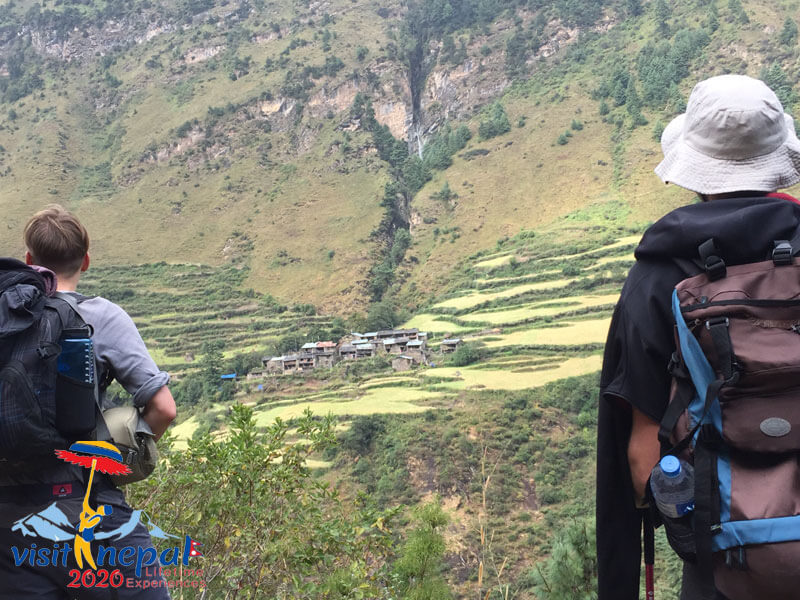
Manaslu Circuit Trek
Manaslu Circuit trek is one of the most appreciated off the beaten path treks in Nepal. It holds the third positions among the top three most popular trekking regions in Nepal for its incredible rewards to the visitors. The visitors going on Manaslu Circuit trekking gets to know typical dialect, culture and religion that differ from most of the urban areas of Nepal. This is one of the best remote treks of Nepal that offers you a wonderful combination of nature, culture, architecture and adventure.
Around Manaslu trek leads you through the less-crowded trail of the Nepalese Himalayas around the 8th highest mountain of the world. The ethnic cultural villages resided by mixed communties and the Tibetan Buddhist followers welcome you heartily. The rugged trail enriches you Nepal Visit with diverse flora and fauna including the amazing view of the snowy peaks including Mt. Manaslu (8,156m).
Starting from a drive to Soti Khola or Aarughat of the historically significant district of Nepal, Gorkha it lets you cross Larkya La Pass (5,160m). Manaslu Larkya Pass trek is the most loved trekking for its lasting memory of nature, culture and adventure at the same time. You can enjoy the stunning views of the snowcapped peaks of Manaslu region, Ganesh Himal and Langtang region in this trip. Similarly, the Manaslu Conservation Area is one of the Himalayan conservation areas of Nepal protecting large varieties of wildlife and vegetation.
Opened only after 1991 for the international tourists, it is a restricted area trekking in Nepal that requires a special trekking permit to visit it. It not only shows you the wonders of nature and culture of Nepal but takes you close to Tibetan Plateau along the ancient salt trading route between Nepal and Tibet. It also offers you a good deal of side trips during the acclimatization day in Samagaun. You will trek up to mystic Manaslu Base Camp (4,800m) by enjoying the mesmerizing view of the Birendra Lake, which is formed due to the deposit of the Manaslu Glacier.
Once you reach the base camp of Manaslu, you will be surprised with the breathtaking view of the surrounding. You realize the glory of Mt. Manaslu including Shringi Himal (7,187m), Ganesh Himal (7,319m), Himal Chuli (7,893m) and other snowcapped peaks. Alternatively, you can also take a short hike to Pungyen Gompa, one of the oldest monasteries of Manaslu region. From Pungyen Gompa, you can have a majestic sight of the Manaslu Glacier that comes down to meet the Birendra Lake.
Although you can do this trekking all times of the year, higher elevated trail may not be appropriate in winter season. The best time for Manaslu Circuit trekking is spring (March to May) and autumn (September to November). Manaslu Tsum Valley trek is an important trekking package that takes you to the hidden valley of this region that contains the authentic Tibetan culture and tradition in Nepal. Tsum Valley offers you the unspoiled nature due to less frequented area and the culture untouched by the modernity.
A1 Excursion Adventure Tours and Travels Pvt. Ltd. has designed magical Manaslu Circuit trekking to give you the lifelong memories of the god-gifted and manmade things. This circuit is best-known for many major attractions, which please you during this remote trek along the tranquil Himalayan route. Let’s take a quick look at the 5 major attractions of Manaslu Base Camp trek.
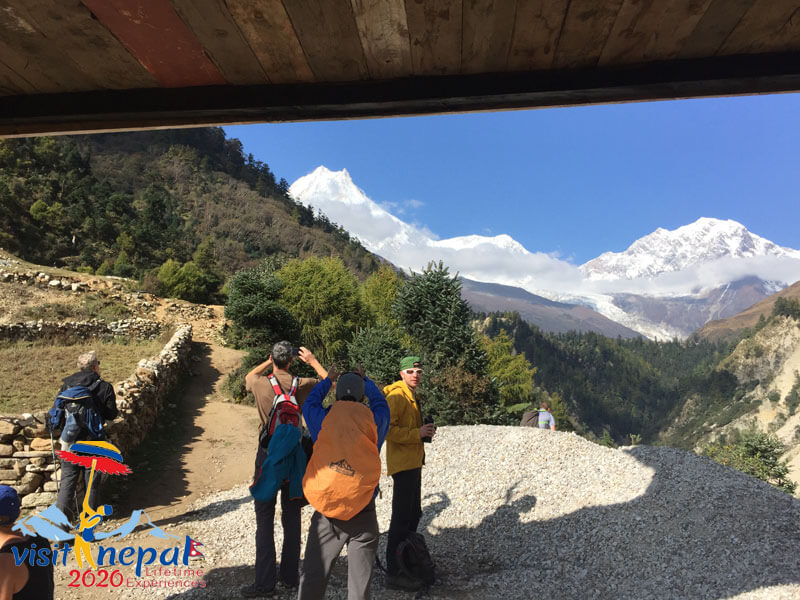
5 Major Attractions of Manaslu Circuit Trek:
Off the Beaten Path Trek:
Among the top 5 major attractions of Manaslu Circuit trek is that it is the less crowded trekking trail. The foreign tourists who love adventurous journey to the Nepalese Himalayas choose this route after Everest region trekking and Annapurna region trekking.Tsum Valley of Manaslu region has from serene nature to incredible cultural flavor. This valley is occupied by the people of Tibetan Buddhist cultural and traditional origin. If you travel around Tsum Valley and Manaslu region, you can all the way walk in solitude to rejoice in yourself. Similarly, you can relish the unspoiled nature and typical culture untouched by the effects of modern technology. Travelling around this region is different from that of Everest region and Annapurna region for it is less frequented by the visitors. If you love to enjoy the camping trekking, you can choose this as the best destination in Nepal.
Cultural and Religious Attractions:
Nubri and Tsum Valleys get their names after the major ethnic communities residing in them and they are divided by the Chhikur River. The settlers of Nubri Valley the people from Gurung ethnic community most of whom are engaged in foreign employment. After Nepal government gave the trekking permits in Manaslu region, Nubri Valley is frequently visited by foreign visitors. Therefore, you can find the effects: both negative and positive of modern culture, tradition and technology in Nubri Valley.
The Bhotias (Bhutias) are the permanent dwellers of Tsum Valley who are almost completely distant from modern world and its discoveries. Likewise, Gurung and Sherpa people also live in Manaslu Tsum Valley and are influenced by Tibetan Buddhist religion. As a result, the village houses chortens, mani walls and ancient Buddhist monasteries reflecting the original Tibetan Buddhist Culture and Tradition. Rachen Nunnery, Mu Monastery and Gumba Lungdang Nunnery are the major monasteries that must be visited while in Tsum Valley. Doing short stroll around the ethnic cultural villages like Chumling, Chhule, Chhekamparo and Nyile offers you the unique culture and tradition.
Tsum Valley is recognized for Pirren Phu (also called Milarepa’s Cave or Pigeon Cave) is one of the most sacred Buddhist shrines. The ancient Tibetan saint, Milarepa is believed to have meditated and got enlightened in this part of the Nepalese Himalayas. Milarepa’s Cave is located near Burji Village of Manaslu Tsum Valley region surrounded by other three separate caves. A large clay statue nearby the natural rocky cave is the tribute to Saint Milarepa who was born in around 1052. The things to explore in the Milarepa’s Cave are the foot prints of Milarepa, statues of Avaloketeshwara, Buddha and Tara.
Adventurous Trip up to Mt. Manaslu (8,156m)
You can take an adventurous trip up to the base camp of Mt. Manaslu (8,156m) but also reach the summit. It is one of the eight-thousanders of Nepal, which is open for the climbers by managing the required process with the concerned authority. The first ascent to Mount Manaslu was made by Toshio Imanishi, Japanese and Gyalgen Norbu, a Sherpa on May 9th 1956. Till now, around 1,100 people have already reached the summit of this 8,000+ metres peak.
If not you can reach the base camp at the height of 4,800m to have the enthralling view of the Manaslu valley and snowcapped peaks. Himlung Himal, Cheo Himal, Kanguru, Siringi, Hiunchuli and Ngadi, Ganesh Himal and Annapurna II (7,937m) unleash their incredible beauty in the sparkling sunrays. Similarly, you can see the Birendra Lake extended in an area of around three-square kilometers at the bottom of the Manaslu Glacier. Last but not the least, you can hike up to Pungyen Gompa to have a gorgeous mountain view and see the architecture of Tibetan Buddhist religion.
Flora and Fauna
Manaslu Conservation Area has been established to protect the endangered species of wildlife and vegetation that makes the environmental balance. The diverse varieties of flora and fauna found in the Himalayan conservation area are the wonderful experience you get during this trek. Manaslu Conservation Area houses 33 species of mammals, 110 species of birds and 210 butterfly species. You can also see the endangered animal species like snow leopard, Himalayan thar and musk deer in the conservation area.
The vegetation of this protected region consists of 19 different types of forests occupied by around 2,000 flowering plants. Himalayan pine and rhododendron including some medicinal plus aromatic plats are the dominant species of plants found here. If you plan to trek Manaslu Circuit during spring season, the colorful flowers of different species decorate it like a bride on her wedding day.
Safe Trekking Region
Safe trekking trail is another attracting feature of Manaslu Circuit Tsum Valley trek although you have to cross Larkya La Pass (5,160m). Larkya La Pass is a challenging high Himalayan pass, which requires great care and safety to cross during winter season. Although you can suffer from Acute Mountain Sickness (AMS), taking precautions on drink, food items and walking speed prevents you from this. Don’t forget to pack Diamox Oral in your first aid kits. As this is entirely a teahouse trekking, you needn’t worry about managing camping trekking gears. You don’t need to spend the nights in the tented camp at the highest altitude which may be quite challenging. Even while crossing Larkya La Pass, you don’t need any climbing gears but can do it as if trekking in other sections of the trekking trail. There is low or no chance for avalanche, blizzard or glacial slides during Manaslu Tsum Valley trek.

Day to Day Itinerary:
Day 01: Reception at the Kathmandu Airport (1,350m)
As soon as you arrive at the Kathmandu Airport, a representative of A1 Excursion welcomes you there. Then, s/he escorts you up to the hotel booked for your accommodation. In the evening, the trekking guide tells you in details about Manaslu Circuit trek 16 days itinerary.
Day 02: Drive to Soti Khola (700m) -9 Hrs
Today, after breakfast, you go towards Soti Khola, the gateway to magical Manaslu region trekking in a private jeep. While driving along the Prithvi Highway, you relish the beautiful scenery scene of cultivated land, snowy peaks of Manaslu region and Langtang region. After about 8/9 hours, you reach Soti Khola for the night stay at a teahouse tasting the delicious cuisines.
Day 03: Trek to MachhaKhola (960m) -6/7 Hrs
You follow the uphill and downhill trail along the densely forested Budhi Gandaki River Valley enjoying the glimpses of mountains. You will also have the amazing sight of some serene villages situated at the top of hills on the way to accompany your journey uphill. You go past a beautiful village Lububeshi at an elevation of 880m before reaching Machha Khola for the night stay.
Day 04: Trek to Jagat (1,410m)
Today, you walk along the trail having stone staircases leading uphill and downhill to reach Jagat for the night stay. You cross a few suspension bridges over some streams to reach different Gurung villages nearby the dense forests. On the way, you see a waterfall of natural hot water, Tatopani where you can take a short break for refreshment. You can also see Langur, a monkey species having long tail on the way.
Day 05: Trek to Deng (1,804m)
By walking uphill and downhill rugged path and crossing few suspension bridges over rivulets, you move further. The astounding view of the dense forests, few rustic Gurung villages and meadows will inspire you for further trekking. By passing some villages like Philim, and EkleBhatti on the banks of the Budhi Gandaki River, you reach Deng for the night station.
Day 06: Trek to Namrung (2,630m)
Now, you follow the rocky trail that goes past the thick alpine forests and classic ethnic houses of Manaslu region. You walk past Prok village, which gives you the vantage of the snowcapped Sringi Himal and several monasteries. By enjoying a distant view of the major majestic peaks of the Manaslu region, you enter into Manaslu Conservation Area. Walking along the steep path, you will reach Namrung for the night rest.
.jpg)
Day 07: Trek to Samagaun (3,530m)
You walk around Namrung village for the finest panorama of Sringi Himal, Ganesh Himal and Mount Himalchuli (7,893m) to the south. After breakfast, you follow the sloppy and steep rugged path to reach your destination, Samagaun. You will walk past Lihi village that houses many monasteries and terraced barley farmland.
You will walk through Lho village that gives you a captivating view of Manaslu region and visit Ribung Gompa, a famous monastery. Similarly, from Shyala village, you can see the staggering sight of Himalchuli, Peak 29 (Ngadi Chuli), Manaslu, Ganesh Himal and some glaciers. With the memories of spellbinding snowy peaks and rustic villages, you will reach Samagaun and spend the night there.
Day 08: Acclimatization in Samagaun
For a day’s acclimatization, you hike up to Manaslu Base Camp by following the rugged trail that goes past the Birendra Lake. Made from the glacial deposit of the Manaslu Glacier, this lake is an important milestone of this trek. By observing the beauty of this around three square kilometres’ glacial lake, you ascend towards the base camp of Mt. Manaslu. You can enjoy the Himalayan view from the base camp. Alternatively, you can also trek to Pungyen Gompa just a few miles away from Samagaun.
Day 09: Trek to Samdo (3,860m)
Today, you will follow the trail that penetrates through the juniper and birch forests on sides to go across Kermo Kharka. By playing ‘hide and seek’ with the Budhi Gandaki River on the way, you reach close to the Tibetan border. Following the steep archway paved with stones, you will reach Samdo for the night station.
Day 10: Second Acclimatization in Samdo
Today is the second acclimatization day at Samdo, so, is free of worry and hurry. You can take enough sleep and rest! To get better acclimatized here, there are two options: one easy and the other challenging. You can walk along one of the oldest trading routes between Nepal and Tibet reaching close to Tibetan border. From here you can see the snow-clad mountains in Manaslu region including Mt. Makalu. You will also see the mountainous birds like lhophophorus (Nepal’s national bird), lammergeyer and Himalayan Griffon hovering just above you! You can also see ‘Doksas’ meaning sheds for seasonal cattle settlements for animal husbandry in the Himalayan region.
The challenging path takes you up to Gya La (estimated 4,796m), one of the high passes in Manaslu Circuit Trek. Quite frequently used trading route between Tibet, this pass grants you a wonderful view of the landscapes and snow-capped peaks located in Manaslu region.
Day 11: Trek to Dharmasala (4,460m)
Today’s Manaslu Circuit trekking distance is quite short but rewards with a perfect combination of natural and cultural attractions. You walk past Larke Bazaar, a seasonal Tibetan market place of the village. You can enjoy the Larkya Glacier and mesmerizing view of the landscapes and snowcapped peaks. By leaving the Salka Khola valley, you reach Dharmasala (also called ‘Larke Phedi’ to spend the night. The traditional Buddhist monasteries located in the villages will greet and see-off you en route.
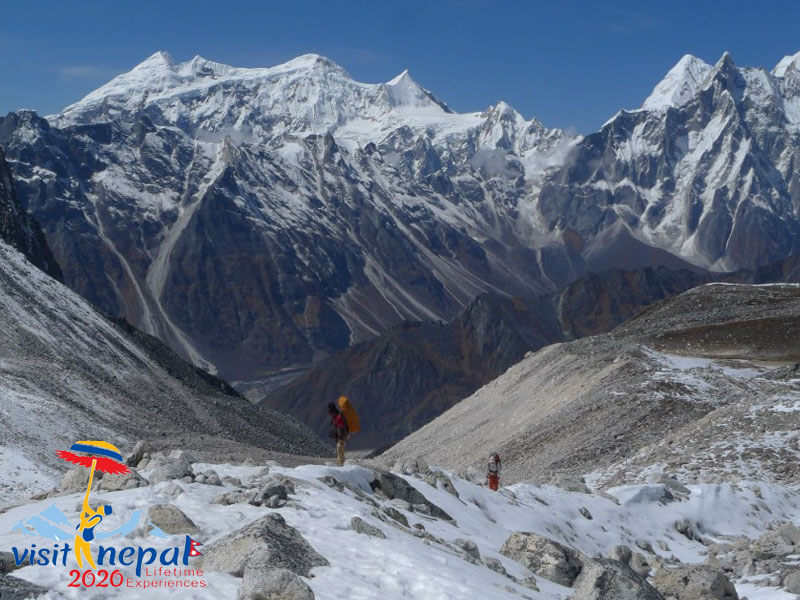
Day 12: Trek to Bhimtang (3,720m) via Larkya La (5,160m)
Today is a challenging trekking, but will be more fantastic as you come to see tantalizing natural scenery. The lovely pastoral villages, glacial lakes, lush valleys, wide variety of wildlife and vegetation including snowy mountains escort you during the journey. From Larkya Glacier, you have a magnificent view of Cho Danda and Larkya Peak. Atop of Larkya La, you can see the gorgeous outlook of Annapurna II, Himlung Himal, Cheo Himal and Mount Manaslu. This is the most remarkable day than rest of the days passed and to come as you have crossed the highest point, Larkya La! After enjoying the astounding sight, you descend towards Bhimthang.
Day 13: Trek to Tilije (2,300m)
While walking downhill from Bhimthang, you enjoy a beautiful glimpse of Mt. Manaslu, Lamjung Himal, Himlung Himal and Cheo Himal. By passing a pasture, you cross the Dudh Khola River Bridge and reach a narrow valley. Then, you walk past Kharche valley which is one of the highest cultivated areas in the high Himalayan region. To reach Tilije, today’s night station, you will have to cross Gho, a stopover during Manaslu region trekking.
Day 14: Trek to Tal (1,700m)
Today is the last day of walking through the trekking trail and spending night in this region. of your Manaslu Circuit Trekking. By following the trail that goes past Thonje, a small village decorated with many walls and chorten-shaped arch. Then, moving ahead through Dharapani, which lies in Annapurna Circuit trekking region, you reach Tal. It is a small beautiful village at the foot of a natural waterfall.
Day 15: Drive from Tal to Kathmandu
Early in the morning in a bus or a private jeep, you begin the roadway journey towards Kathmandu. During the drive, you will capture the mesmerizing appearance of the Manaslu region rich in snow-capped peaks and appealing landscapes for the last time to this season. You will arrive in Kathmandu within 8 hours and go to the hotel for rest. In the evening, our agency organizes a farewell dinner party at a typical Nepali restaurant as a part of hospitality.
Day 16: Departure from Kathmandu or New Plan
This is the last day of 18 days Manaslu Circuit Trek itinerary. Therefore, a team member of A1 Excursion accompanies you up to the Tribhuvan International Airport for farewell according to your flight schedule.
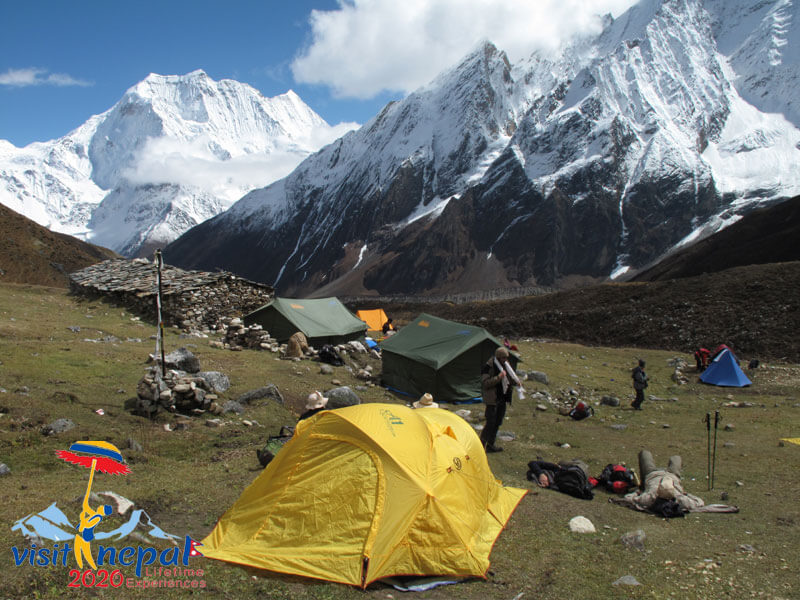
Necessary Trekking Gears:
- Duffel or Rucksack bag (Provided)
- Down Sleeping bag (Provided)
- Down Jacket (Provided)
- Daypack
- Hiking pants
- Waterproof & Windproof jacket
- Rain coat or Umbrella
- Full-sleeves shirts
- Jumper or Fleece jacket
- Pair of T-shirts
- Trekking Boots (water proof is better)
- Sandal, Toilet paper
- Cotton thick socks (2 pair), Woolen socks to wear with boots
- Sun-hat & fleece hat
- Gloves
- Scarf
- Sun block for lips
- Sun lotion
- Goggles or Sunglasses
- Thermal long underwear sets
- Insulated pants
- Trekking poles
- Wind breaker pants
- Water bottle
- Flash light or Head light, Batteries
- Swiss army Knife
- Personal Dry Towel
- Personal toiletries and medication which should be labeled
- Crampons
- Snow leg Gaiters


.webp)
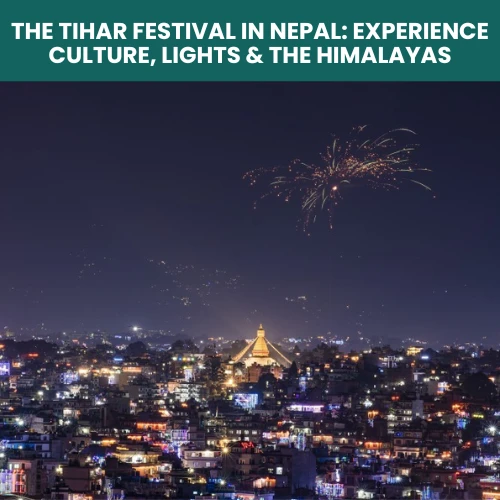
.webp)